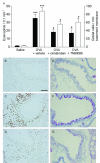Antagonism of the prostaglandin D2 receptor CRTH2 attenuates asthma pathology in mouse eosinophilic airway inflammation
- PMID: 17328802
- PMCID: PMC1810525
- DOI: 10.1186/1465-9921-8-16
Antagonism of the prostaglandin D2 receptor CRTH2 attenuates asthma pathology in mouse eosinophilic airway inflammation
Abstract
Background: Mast cell-derived prostaglandin D2 (PGD2), may contribute to eosinophilic inflammation and mucus production in allergic asthma. Chemoattractant receptor homologous molecule expressed on TH2 cells (CRTH2), a high affinity receptor for prostaglandin D2, mediates trafficking of TH2-cells, mast cells, and eosinophils to inflammatory sites, and has recently attracted interest as target for treatment of allergic airway diseases. The present study involving mice explores the specificity of CRTH2 antagonism of TM30089, which is structurally closely related to the dual TP/CRTH2 antagonist ramatroban, and compares the ability of ramatroban and TM30089 to inhibit asthma-like pathology.
Methods: Affinity for and antagonistic potency of TM30089 on many mouse receptors including thromboxane A2 receptor mTP, CRTH2 receptor, and selected anaphylatoxin and chemokines receptors were determined in recombinant expression systems in vitro. In vivo effects of TM30089 and ramatroban on tissue eosinophilia and mucus cell histopathology were examined in a mouse asthma model.
Results: TM30089, displayed high selectivity for and antagonistic potency on mouse CRTH2 but lacked affinity to TP and many other receptors including the related anaphylatoxin C3a and C5a receptors, selected chemokine receptors and the cyclooxygenase isoforms 1 and 2 which are all recognized players in allergic diseases. Furthermore, TM30089 and ramatroban, the latter used as a reference herein, similarly inhibited asthma pathology in vivo by reducing peribronchial eosinophilia and mucus cell hyperplasia.
Conclusion: This is the first report to demonstrate anti-allergic efficacy in vivo of a highly selective small molecule CRTH2 antagonist. Our data suggest that CRTH2 antagonism alone is effective in mouse allergic airway inflammation even to the extent that this mechanism can explain the efficacy of ramatroban.
Figures


Similar articles
-
Role of prostaglandin D2 receptor CRTH2 in sustained eosinophil accumulation in the airways of mice with chronic asthma.Int Arch Allergy Immunol. 2011;155 Suppl 1:6-11. doi: 10.1159/000327257. Epub 2011 Jun 1. Int Arch Allergy Immunol. 2011. PMID: 21646789
-
Antagonists of the prostaglandin D2 receptor CRTH2.Drug News Perspect. 2008 Jul-Aug;21(6):317-22. doi: 10.1358/dnp.2008.21.6.1246831. Drug News Perspect. 2008. PMID: 18836589 Review.
-
Inhibition of antigen-induced airway inflammation and hyperresponsiveness in guinea pigs by a selective antagonist of "chemoattractant receptor homologous molecule expressed on Th2 cells" (CRTH2).Eur J Pharm Sci. 2013 Jun 14;49(3):434-40. doi: 10.1016/j.ejps.2013.04.017. Epub 2013 Apr 24. Eur J Pharm Sci. 2013. PMID: 23624353
-
On the mechanism of interaction of potent surmountable and insurmountable antagonists with the prostaglandin D2 receptor CRTH2.Mol Pharmacol. 2006 Apr;69(4):1441-53. doi: 10.1124/mol.105.017681. Epub 2006 Jan 17. Mol Pharmacol. 2006. PMID: 16418339
-
Ramatroban (BAY u 3405): a novel dual antagonist of TXA2 receptor and CRTh2, a newly identified prostaglandin D2 receptor.Cardiovasc Drug Rev. 2004 Summer;22(2):71-90. doi: 10.1111/j.1527-3466.2004.tb00132.x. Cardiovasc Drug Rev. 2004. PMID: 15179446 Review.
Cited by
-
Regulation of Th9-type pulmonary immune responses: a new role for COX-2.Am J Respir Crit Care Med. 2013 Apr 15;187(8):785-6. doi: 10.1164/rccm.201302-0205ED. Am J Respir Crit Care Med. 2013. PMID: 23586375 Free PMC article. No abstract available.
-
Ramatroban for chemoprophylaxis and treatment of COVID-19: David takes on Goliath.Expert Opin Ther Targets. 2022 Jan;26(1):13-28. doi: 10.1080/14728222.2022.2031975. Epub 2022 Feb 22. Expert Opin Ther Targets. 2022. PMID: 35068281 Free PMC article. Review.
-
Efficacy and safety of the CRTh2 antagonist AZD1981 as add-on therapy to inhaled corticosteroids and long-acting β2-agonists in patients with atopic asthma.Drug Des Devel Ther. 2018 May 4;12:1093-1106. doi: 10.2147/DDDT.S147389. eCollection 2018. Drug Des Devel Ther. 2018. PMID: 29765200 Free PMC article. Clinical Trial.
-
Role of prostaglandin D2 /CRTH2 pathway on asthma exacerbation induced by Aspergillus fumigatus.Immunology. 2014 May;142(1):78-88. doi: 10.1111/imm.12234. Immunology. 2014. PMID: 24329550 Free PMC article.
-
An epigenome-wide association study of total serum IgE in Hispanic children.J Allergy Clin Immunol. 2017 Aug;140(2):571-577. doi: 10.1016/j.jaci.2016.11.030. Epub 2017 Jan 6. J Allergy Clin Immunol. 2017. PMID: 28069425 Free PMC article.
References
-
- Lewis RA, Soter NA, Diamond PT, Austen KF, Oates JA, Roberts LJ., 2nd Prostaglandin D2 generation after activation of rat and human mast cells with anti-IgE. J Immunol. 1982;129(4):1627–1631. - PubMed
-
- Fujishima H, Fukagawa K, Okada N, Takano Y, Tsubota K, Hirai H, Nagata K, Matsumoto K, Saito H. Prostaglandin D2 induces chemotaxis in eosinophils via its receptor CRTH2 and eosinophils may cause severe ocular inflammation in patients with allergic conjunctivitis. Cornea. 2005;24(8 Suppl):S66–S70. doi: 10.1097/01.ico.0000178733.42921.4c. - DOI - PubMed
Publication types
MeSH terms
Substances
LinkOut - more resources
Full Text Sources
Other Literature Sources
Medical

